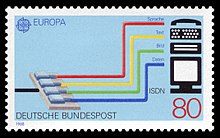Japan
On April 19, 1988, Japanese telecommunications company NTT began offering nationwide ISDN services trademarked INS Net 64, and INS Net 1500, a fruition of NTT's independent research and trial from the 1970s of what it referred to the INS (Information Network System).[9]Previously, on April 1985, Japanese digital telephone exchange hardware made by Fujitsu was used to experimentally deploy the world's first I interface ISDN. The I interface, unlike the older and incompatible Y interface, is what modern ISDN services use today.
Since 2000, NTT's ISDN offering have been known as FLET's ISDN, incorporating the "FLET's" brand that NTT uses for all of its ISP offerings.
In Japan, the number of ISDN subscribers dwindled as alternative technologies such as ADSL, cable Internet access, and fiber to the home gained greater popularity. On November 2, 2010, NTT announced plans to migrate their backend from PSTN to the IP network from around 2020 to around 2025. For this migration, ISDN services will be retired, and fiber optic services are recommended as an alternative.[10]
United Kingdom
In the United Kingdom, British Telecom (BT) provides ISDN2e (BRI) as well as ISDN30 (PRI). Until April 2006, they also offered services named Home Highway and Business Highway, which were BRI ISDN-based services that offered integrated analogue connectivity as well as ISDN. Later versions of the Highway products also included built-in Universal serial bus (USB) sockets for direct computer access. Home Highway was bought by many home users, usually for Internet connection, although not as fast as ADSL, because it was available before ADSL and in places where ADSL does not reach.France
France Telecom offers ISDN services under their product name Numeris (2 B+D), of which a professional Duo and home Itoo version is available. ISDN is generally known as RNIS in France and has widespread availability. The introduction of ADSL is reducing ISDN use for data transfer and Internet access, although it is still common in more rural and outlying areas, and for applications such as business voice and point-of-sale terminals.Germany
In Germany, ISDN is very popular with an installed base of 25 million channels (29% of all subscriber lines in Germany as of 2003 and 20% of all ISDN channels worldwide). Due to the success of ISDN, the number of installed analog lines is decreasing. Deutsche Telekom (DTAG) offers both BRI and PRI. Competing phone companies often offer ISDN only and no analog lines. However, these operators generally offer free hardware that also allows the use of POTS equipment, such as NTBAs[11] with integrated terminal adapters. Because of the widespread availability of ADSL services, ISDN is today primarily used for voice and fax traffic, but is still very popular thanks to the pricing policy of German telecommunication providers.Today ISDN (BRI) and ADSL/VDSL are often bundled on the same line, mainly because the combination of ADSL with an analog line has no cost advantage over a combined ISDN-ADSL line. Some German operators started to implement Next Generation Networking, generally realized via DSL and unbundled local loop. However, a few operators offer the same services via the cable television infrastructure or, in selected areas, via FTTH. Because of the popularity of ISDN, virtually all these telecommunication providers bundle their products with residential gateways that include both integrated analog telephony adapters and ISDN-NGN adapters.
Greece
OTE, the incumbent telecommunications operator, offers ISDN BRI (BRA) services in Greece. Following the launch of ADSL in 2003, the importance of ISDN for data transfer began to decrease and is today limited to niche business applications with point-to-point requirements.Other ISDN providers are Reliance, and VSNL.








0 comments:
Post a Comment
Note: only a member of this blog may post a comment.